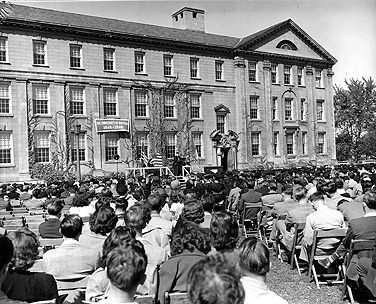Flashback
65 years ago
The Centennial

Opening convocation of the centennial celebration, Crosby Hall, Oct. 2, 1946. Photo: UB ARCHIVES
UB turned 100 in 1946, and the milestone did not go unnoticed.
On May 11, 1946, the 100th anniversary UB’s founding, the medical school celebrated its centennial. A series of symposia sponsored by the School of Nursing, the chemistry department and the School of Law took place during the summer.
As a prelude to the general centennial celebration scheduled for Oct. 3 and 4, the medical school held symposia on body proteins, cancer and cardiac disease. More that 1,000 physicians representing 27 universities and other organizations were in attendance.
The events of Oct. 3 and 4 began with a convocation on the quadrangle facing Crosby Hall. Chancellor Samuel P. Capen delivered the opening address before a plaque was unveiled honoring UB alumni who were among the causalities of World War II.
It was during this address at the opening convocation that Capen made his stirring defense of academic freedom. A university, he said, “is an instrument of inquiry. It is a forum of criticism and interpretation. It is an incubator of ideas. It is a nursery of free men, and as such it is democracy’s strongest bulwark. Only by exercising the prerogatives and the responsibilities of freedom do men learn to be free and to be strong. The most precious of all these prerogatives is freedom of the mind, and it entails the gravest of all responsibilities. To the free exercise of the mind, this university is irrevocably committed.”
The dedication of Parker Hall took place in the afternoon, followed by an alumni banquet in the Hotel Statler in downtown Buffalo. On the second day, there was a conference in Kleinhans Music Hall on the future of university education, followed by the Centennial Convocation with more than 200 delegates from other colleges and universities in attendance.
Breaking a long-standing precedent, UB presented honorary degrees at the convocation. Among the 11 recipients were physician and poet William Carlos Williams; engineer Vannevar Bush, president of the Carnegie Institution and a key figure with the Manhattan Project; Mildred McAfee Horton, president of Wellesley College and former head of the Waves; and Supreme Court Justice Robert H. Jackson.
Jackson, who had served as chief U.S. prosecutor at Nuremberg—the tribunals held to try prominent leaders of Nazi Germany at the end of World War II—presented the convocation address. Speaking publicly for the first time since the conclusion of the trials, he described how war and dictatorship are so interrelated that “little progress can be made toward permanent peace without solving the problem of protecting the elementary rights of minorities.”
An impressive public relations brochure—“The Greater University of Buffalo”—was issued for the centennial. After outlining the current status of the history of the university, it concluded with the question: “As it reaches this milestone in its development, what does the university regard as its greatest need?
The answer—additional endowment funds—was not unlike one that might be given to a similar question today. “The university must strengthen its financial structure. It must have more endowed professorships. It must improve and extend research activities and must acquire new and additional equipment for most of its divisions. It must erect and enlarge several buildings. It must provide additional scholarships.”
Several years after the centennial celebration, Julian Park, dean of the College of Arts and Sciences, made this observation about the festivities: “After this orgy of culture and inspiration, it must have been hard to get back to work.”
A collection of material from the centennial events, including scrapbooks and photographs, are available in the University Archives. The official proceedings for the centennial were published as “Centennial Celebration of the University of Buffalo, 1846-1946” and is available online as part of the ”Best of the UB Archives.” The memorial plaque is also in the University Archives.

Reader Comments
Shonnie Finnegan says:
Excellent article, as always. John Edens has mastered the archival source materials for the fascinating history of the university, and shows such a gift for bringing the most interesting and pertinent details together in a articles such as this one.
Too bad he is now retired with no effort on the part of the Library administration to bring on a successor Univ. Archivist in time to learn the ropes from John.
Posted by Shonnie Finnegan, University Archivist Emerita, 10/20/11